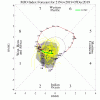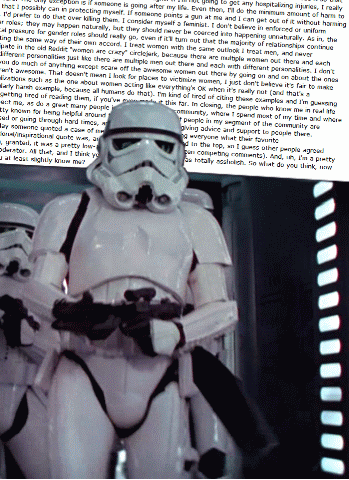Since the start of December is now within the proverbial 10 day window, I'm going to go ahead and hoist the thread. The next 10 days or so should average seasonal to mild, bringing us into early December, where things begin to become less certain. How will the month play out? Well, there are some things to be optimistic about and there are some things to be less optimistic about. Here is the TLDR version. For the cliff notes, please skip down to the summary section at the bottom:
TLDR Version:

Since the start of December is now within the proverbial 10 day window, I'm going to go ahead and hoist the thread. The next 10 days or so should average seasonal to mild, bringing us into early December, where things begin to become less certain. How will the month play out? Well, there are some things to be optimistic about and there are some things to be less optimistic about.
The case for a below normal December:
1) There has been a tendency for a -NAO and blocking to show up in a favorable region, supporting a cooler eastern US. This is a good sign as we head into winter.
2) There has been an active STJ, along with several coastals. This is also a good sign, arguing for frequent clouds and precipitation chances.
3) There is a case to be made for the emergence of a stout -EPO regime, favoring cold air transport into the US, probably centered over the Plains. The orientation and position of the EPO ridge will make the difference for whether or not the SE can get cold or stay seasonal.
4) Warming of the stratosphere could lead to enhanced blocking, featuring a turn to cold later in the month.
5) So far, warm patterns seem to get pushed back or are transient, with no static SE ridge.
6) The MJO doesn't appear to want to hang out for weeks and weeks in the warm phases.
7) I like the Aleutian low that keeps wanting to appear.
The case against a below normal December:
1) Recent climatology. It has been forever since we've seen a below normal December. Given a warmer overall background state, there may be other forces at work that we don't fully understand, leading to warmer conditions to start winter.
2) Warm-neutral/weak +ENSO conditions tend to favor an AN December.
3) The NAO looks to break down. This may turn out to be ok, if we get a strong -EPO, positioned correctly. However, incorrectly positioned, it could hand-shake with a -PNA, creating a semblance of a SE ridge.
4) Some seasonal modeling, though I'm not sure how much predictive value they really carry, show a warm December.
5) Ridging north of HI has been showing up, which argues for riding in the east, all else equal.
I'm sure there are other items in both camps. Feel free to add them if you think of them.
Anyway, here are some maps and charts to start us off:
6z 240 hr GEFS:

6z 384 hr GEFS:

0z 240 hr GEPS:

0z 240 hr EPS:

CFS December:

CPC Climate Indexes:

EMWESYWFYCWF MJO:

EPO:


Summary:
My feeling is that we average near or slightly below normal for the month and will see at least one winter storm.
Merry Christmas and Happy Holidays!
Welcome to winter!
TLDR Version:

Since the start of December is now within the proverbial 10 day window, I'm going to go ahead and hoist the thread. The next 10 days or so should average seasonal to mild, bringing us into early December, where things begin to become less certain. How will the month play out? Well, there are some things to be optimistic about and there are some things to be less optimistic about.
The case for a below normal December:
1) There has been a tendency for a -NAO and blocking to show up in a favorable region, supporting a cooler eastern US. This is a good sign as we head into winter.
2) There has been an active STJ, along with several coastals. This is also a good sign, arguing for frequent clouds and precipitation chances.
3) There is a case to be made for the emergence of a stout -EPO regime, favoring cold air transport into the US, probably centered over the Plains. The orientation and position of the EPO ridge will make the difference for whether or not the SE can get cold or stay seasonal.
4) Warming of the stratosphere could lead to enhanced blocking, featuring a turn to cold later in the month.
5) So far, warm patterns seem to get pushed back or are transient, with no static SE ridge.
6) The MJO doesn't appear to want to hang out for weeks and weeks in the warm phases.
7) I like the Aleutian low that keeps wanting to appear.
The case against a below normal December:
1) Recent climatology. It has been forever since we've seen a below normal December. Given a warmer overall background state, there may be other forces at work that we don't fully understand, leading to warmer conditions to start winter.
2) Warm-neutral/weak +ENSO conditions tend to favor an AN December.
3) The NAO looks to break down. This may turn out to be ok, if we get a strong -EPO, positioned correctly. However, incorrectly positioned, it could hand-shake with a -PNA, creating a semblance of a SE ridge.
4) Some seasonal modeling, though I'm not sure how much predictive value they really carry, show a warm December.
5) Ridging north of HI has been showing up, which argues for riding in the east, all else equal.
I'm sure there are other items in both camps. Feel free to add them if you think of them.
Anyway, here are some maps and charts to start us off:
6z 240 hr GEFS:

6z 384 hr GEFS:

0z 240 hr GEPS:

0z 240 hr EPS:

CFS December:

CPC Climate Indexes:

EMWESYWFYCWF MJO:

EPO:


Summary:
My feeling is that we average near or slightly below normal for the month and will see at least one winter storm.
Merry Christmas and Happy Holidays!
Welcome to winter!
Last edited:















